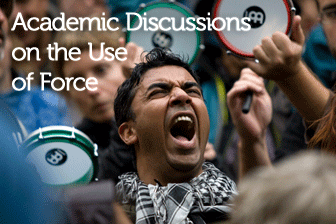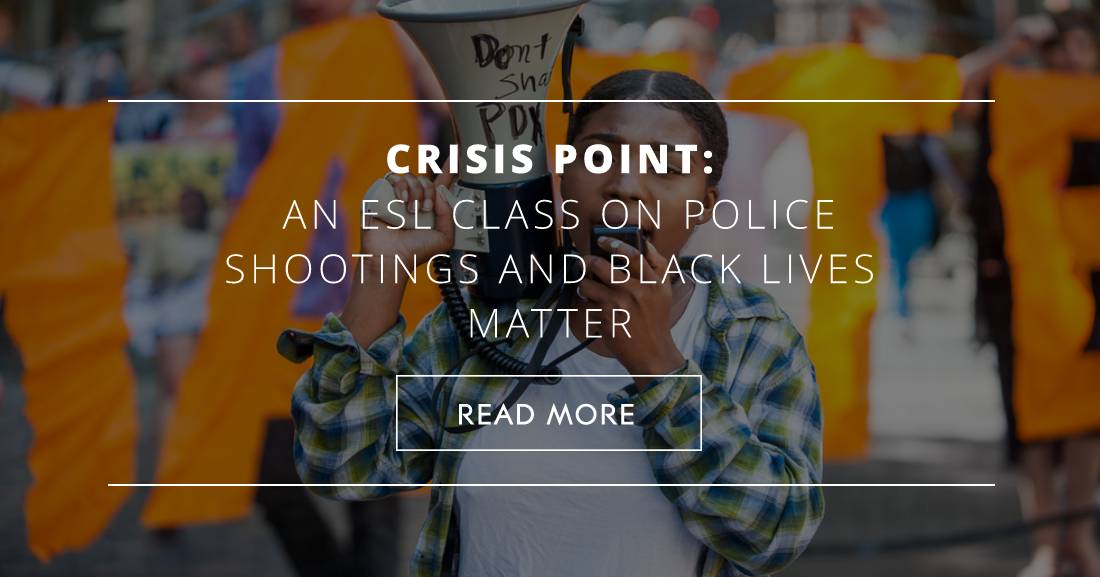From “Shooting an Elephant” to the Occupy Movement: Academic Discussions on the Use of Force


The US in particular is struggling with issues relating to race, crime, poverty and inequality, and these problems have received intensive coverage in the media, and strong focus across social media platforms. For the most part, my students come from countries where police shootings are rare, where gun ownership is difficult or impossible, and where racial tensions are not a focus of public discussion, so I felt it would be enlightening and useful to discuss the Black Lives Matter movement with my students.
I’m glad that I did. Inviting my students to think, read and talk about these matters exposed them to new ideas and helped them to understand just how difficult and tragic the situation has become. This was also a way to provide my students with experience of discussing racial matters, and to cover some of the relevant vocabulary. I have to say that, during these lessons, I found a very mixed response from my students; some exhibited prejudicial points of view which I found very difficult to handle, though others quickly grasped the nature of the problem. Teaching these topics took more preparation than usual, and careful research into the topic, but the additional work was very worthwhile.
It’s essential that your students understand a little of the history of race relations in the US. Take as much time as possible to talk, research and write about slavery, Jim Crow, the Civil Rights Movement and the work and legacy of Dr. King, inner city poverty and racism. Try to identify where racism comes from and how it flourishes and foments social division and strife. Discuss the fear of ‘the other’, how the media and other organizations have depicted non-white Americans, and the stereotypes to which this has given rise.
Partner this with questions about race relations in your students’ home countries. If they come from Europe, they’ll probably have opinions and stories about the migrant crisis, and how this is affecting European societies. Asian students tend to find it more difficult to envisage living within a non-homogenous society, so provide help with pictures, anecdotes, field trips, museum visits, guest speakers and anything else which might help them to visualize how modern America looks and sounds.
As I said, some of my students’ reactions to this topic were very disappointing. I’d be the first to agree that our role as ESL teachers is to facilitate language practice, and not to change viewpoints. However, if a student asserts that African-Americans are poor because of low intelligence, or that young black men are inherently violent, then I cannot imagine a responsible teacher allowing those views to remain unchallenged. Such students are speaking in absence of the full facts, and under the influence of divisive, unkind, irresponsible social philosophies which are very gradually dying out. Personally, though I cringe when I hear comments of this nature, and require the student to explain their views, I’m encouraged that I hear fewer racist comments with each passing year.
Here are the main points I make sure to reinforce:
Your students should learn and apply the notion that not every American has equal access to education, healthcare and the means of personal fulfillment. Urban decay, outsourcing, bankrupted cities and adversarial policing all lead to high crime rates and recidivism, to broken families and wrecked careers, and to a major shortfall in academic achievement and personal success. Reinforce the idea that these are environmental causes of crime and poor community relations, and that they have nothing inherently to do with the race of the people involved.
Some countries have police forces which are heavily armed or which have specialist firearms teams to respond to dangerous incidents. But the US approach of routinely arming all of their law enforcement officials - including highway patrol officers, college campus police, mall cops and such - is unique. Perhaps unsurprisingly, the predominance of firearms has had a debilitating and often catastrophic effect on police relations with the community, and there have been hundreds of incidents of police shootings, including those which appeared not to have been absolutely necessary.
The militarization of the police is another controversial topic, and this has led to a reappraisal of the role of law enforcement. Your students should understand that, in many US cities, the perception of police is a far cry from the concerned, involved, engaged approach practiced elsewhere, and this has resulted in a dangerous and divisive ‘us and them’ mentality. Further complicating matters are long-standing allegations of institutional racism and the controversial use of racial profiling by police officers.
Cultural change is slow. While many of the criticisms of police are unfair, and some are rooted in bias and resentment, all too often investigations sweep problems under the rug or fail to responsibly assign blame. We can only anticipate that these cultural problems will continue.
Ask your students to research perceptions of the police, and how the public feels about their enforcement officials being routinely armed. Does it make the public safer, or does it make conflict and tragedy more likely? What policies would your students introduce to combat poor police relations with the community? How can they bridge the gap in areas which are blighted by unemployment and poor schooling?
When the Black Lives Matter movement first emerged following the shooting death of Trayvon Martin in 2012, and then grew in the wake of the death of Eric Garner in 2014, certain elements of the media were criticized for their coverage. Have your students track these issues and discover allegations that the media paints a racially biased picture of criminals.
Ask your students to research the origins of the phrase ‘Black Lives Matter’ and its counterpoints, ‘All Lives Matter’, ‘Blue Lives Matter’ and “White Lives Matter’. Also, set research tasks relating to the expressions, “Hands Up, Don’t Shoot!” and ‘I Can’t Breathe’, which became protest slogans for the movement to end police brutality and racism.
Simply teaching and discussing the main points might not be enough to thoroughly inform your students on this complex matter. If time permits, set additional research, presentation and discussion tasks to reinforce this learning:
Research into individual cases, followed by presentations (perhaps including movie clips, sections of documentaries, news reports, etc)
Interviews can be extremely valuable and memorable, if they can be arranged. The chance to interview a serving officer, community activist, preacher, lawyer, convict, researcher or journalist on these topics could be priceless.
A growing number of documentary films is now available, and these can act as a useful listening and discussion exercise for your students, as well as offering a welcome change of pace. Although the whole series is too long for most purposes, O.J.: Made in America is a successful and instructive piece of documentary film-making and would provide a good grounding in race relations.
This might not be possible to arrange, but taking your students on a field trip to experience a protest would be a remarkable and memorable experience.
This would take special preparation and research, but presenting the evidence to your students in the cases of Trayvon Martin, Eric Garner and others would be a powerful way to make points about race and crime in modern America. Defense and prosecution teams could be given time to prepare their cases, with the ‘jury’ consisting of the entire class, so that they can play more than one role in the case and aren’t required simply to listen.
Your students should be aware that these problems are real, and that rather than assigning blame, solutions can be found through partnership, dialogue and open discussion. I try to bring a hopeful and positive tone to these classes, reminding my students that many of the world’s great injustices have been gradually brought to an end by the selfless and courageous actions of a few dedicated people. I hope that this complex topic offers opportunities for language practice, certainly, but also a chance to see the US as a country grappling with its demons, struggling to find justice and peace, but committed to embracing both.